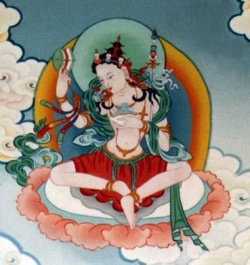Red in Buddhist Symbolism
In Buddhism, red throughout the development of civilization has had connotations with life and those things considered sacred in some way. It has developed as synonymous with the preservation of our life force, as in the symbols of the Red Cross and Red Crescent. Danger signs and signals are also often surrounded in red to indicate warning or threat to life. Similarly, fire has two facets. It can be a warming lifesaver or an uncontrollable destroyer.
The color red is auspicious in Tibetan culture.
It is a sacred color, one of the colors of the five Buddhas and the color of the monk's garments.
It is believed to have protective qualities and is therefore often used to paint sacred buildings. In neighboring China, coral is a symbol of longevity, and in India it is thought to prevent hemorrhages.
Hans Weihreter records beliefs about coral in western Tibetan cultures which center around blood.
Coral is said to strengthen blood, and act beneficially for the menstruation of women.
The symbolism of the color red shines forth in Buddhist aesthetics in the type of paintings known as red thangkas.
A style requiring high technical virtuosity, all elements making up these painting are subsumed in the overall red field characteristic of this special genre of thangka.
Red is the color of powerful rituals and deeds. It is the color of passion, transmuted to discriminating wisdom.
These are especially relevant in especially vigorous meditation rituals requiring equally potent meditative tools.
Another dimension regarding the color red is the belief surrounding coral, the semi-precious stone which is a gift from our mother ocean to remind us of our eternal foundation.
It is actually composed of the skeletons of little animals into reef-plant - like with hard branches.
It reminds us of our bones - hard and durable. Coral teaches us form, also flow and flexibility within form. It lives and breathes in the sea but its roots are anchored in the earth.
It is one of the five sacred stones of the Tibetan Buddhists, and symbolizes the energy of life force.
Coral is believed to be a protection against the evil eye.
In a curious belief it was supposed to lighten in color and become pale if the wearer were ill or even exposed to illness - or were given poison. The coral would then darken as the wearer recovered.
The same attribute was associated with a woman's menstrual periods, which the coral was supposed to "share" with women.
Coral was also associated with stopping the flow of blood from a wound, curing madness, imparting wisdom, and calming storms.
In Buddhism coral is believed to be generally good, and the Tibetans and Tibeto-Nepalese think of it as a good investment, and believe that the person who wears coral will have success in life.


